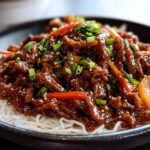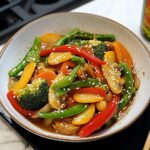The beauty of this egg fried rice lies in its simplicity and punchy flavors. With fluffy rice, crispy bacon, golden eggs, and sweet veggies, it’s a 15-minute meal that hits every note. The key is in the sauce—a quick blend of Chinese cooking wine, soy sauce, and oyster sauce that gives it that authentic restaurant flavor.
Perfect for busy weeknights or as a quick side to your favorite Asian dishes, this fried rice is endlessly customizable. Toss in shrimp, tofu, or leftover chicken to make it heartier. It’s fast, flexible, and incredibly satisfying. Keep a batch of cooked rice in the fridge, and you’re always minutes away from a crave-worthy bowl.
Full Recipe:
-
2 tbsp vegetable oil
-
1/2 onion, finely chopped
-
2 garlic cloves, minced
-
120 g (4 oz) bacon, chopped (optional or use ham)
-
1 1/2 cups mixed vegetables (frozen or fresh – peas, carrots, corn)
-
2 cups cold, cooked white rice (preferably day old)
-
3 large eggs, whisked
-
3/4 cup green onions, chopped
Sauce:
-
1 tbsp Chinese cooking wine (or Mirin)
-
1 tbsp oyster sauce
-
1 tbsp light soy sauce
-
1 tsp sesame oil (optional)
-
1/4 tsp white pepper
Directions:
-
Heat 1.5 tbsp oil in a wok or large skillet over high heat until hot and shimmering.
-
Add chopped onion, garlic, and bacon. Cook for about 1 1/2 minutes until bacon is light golden.
-
Add mixed vegetables (no need to thaw if frozen). Stir-fry for 2 minutes until defrosted and moisture has evaporated.
-
Add cold rice and sauce ingredients. Stir-fry for about 1 1/2 minutes until well combined and the liquid has evaporated.
-
Push rice to the side of the wok. Add remaining oil, pour in eggs, and scramble until cooked through.
-
Stir scrambled eggs into the rice mixture. Add green onions, toss everything together, and serve hot.
Prep Time: 10 minutes | Cooking Time: 5 minutes | Total Time: 15 minutes
Kcal: 522 kcal | Servings: 3 servings
Introduction to Egg Fried Rice
Egg Fried Rice is one of the most beloved staples in Asian cuisine, celebrated for its simplicity, versatility, and comforting flavor. This humble dish originated in China but has evolved into countless regional and global variations, each infused with its own local flair. Whether served as a standalone dish or a side to complement a wider spread of Asian delicacies, Egg Fried Rice offers the perfect blend of savory flavors, textures, and quick cooking ease.
The version featured by RecipeTin Eats captures everything that makes Egg Fried Rice a kitchen favorite. With the rich umami from soy and oyster sauce, the aroma of garlic and onions, the crisp bite of vegetables, and the richness of scrambled eggs—this is a dish that feels indulgent yet remains easy to prepare. The addition of bacon offers a unique twist, adding smoky depth and texture to the traditional flavor profile.
What Makes This Recipe Stand Out
What truly sets this Egg Fried Rice apart is its dedication to replicating the irresistible flavor of Chinese restaurant-style fried rice. The secret? The sauce. Many home cooks miss the mark by overlooking the importance of the sauce’s balance or using overly simplistic combinations. This recipe includes Chinese cooking wine (or mirin), light soy sauce, and oyster sauce—the trio that forms the backbone of that savory, slightly sweet, and deeply satisfying taste that defines professional-quality fried rice.
Another highlight is the method. Instead of cooking eggs separately and adding them at the end, the recipe calls for a technique borrowed from Thai stir-fries: scrambling the egg directly in the wok after pushing the rice aside. This infuses the dish with a richer egg flavor, distributes it more evenly, and helps maintain the right texture in each bite.
The Importance of Cold, Day-Old Rice
Many people underestimate the impact that rice texture has on fried rice. The RecipeTin Eats version emphasizes the need for cold, day-old rice, which has had time to dry out in the fridge. Freshly cooked rice contains too much moisture and tends to become mushy or clump together when stir-fried. Cold rice, by contrast, separates easily and crisps up better in the wok, yielding the perfect fluffy, golden grains that characterize exceptional fried rice.
You can use leftover white long grain rice, jasmine, or even basmati or brown rice—though each will impart its own texture and subtle flavor nuances. For best results, spread the rice out on a tray and refrigerate it overnight to dry out further.
Versatility and Adaptability
Egg Fried Rice is perhaps one of the most adaptable recipes in any cook’s repertoire. The base recipe is a delicious foundation, but you can tailor it to suit your preferences or what’s in your fridge.
For protein, bacon is a flavorful addition that crisps beautifully and renders fat to sauté the vegetables. However, you can easily substitute this with chopped ham, leftover chicken, shrimp, tofu, or even tempeh for a vegetarian version.
The vegetables are equally flexible. The recipe uses a frozen medley of corn, peas, and carrots for convenience and speed, making it a go-to for weeknight dinners. However, you can swap in freshly chopped veggies such as bell peppers, green beans, mushrooms, cabbage, or broccoli. Asian greens like bok choy or Chinese broccoli (gai lan) also work beautifully, offering a more authentic stir-fry feel.
This versatility also makes the dish great for meal prepping. Double the batch and keep leftovers refrigerated. Reheat in a hot skillet or microwave with a splash of water to restore moisture.
Health Considerations
Though Egg Fried Rice may seem indulgent, it can be a well-rounded and nourishing meal when approached thoughtfully. The presence of protein (from the eggs and optional bacon), fiber (from vegetables), and carbohydrates (from the rice) make it a balanced option.
You can make it healthier by opting for low-sodium soy sauce, reducing or skipping the oyster sauce, or using leaner proteins like shrimp or tofu. Swapping white rice for brown rice increases the fiber content and slows the glycemic impact, making it suitable for more health-conscious eaters.
Using minimal oil and loading up on vegetables also improves the nutritional profile. For a lighter variation, consider using just egg whites or reducing the quantity of egg used.
Cooking Equipment: Wok vs. Skillet
Traditionally, fried rice is cooked in a wok—a wide, round-bottomed pan that allows for high heat and quick tossing. The wok’s shape makes it ideal for stir-frying, as food cooks evenly and fast with minimal oil.
However, not everyone has a wok at home, and the recipe accommodates this by recommending a large skillet. The key is to use a high heat setting and a pan large enough to toss the ingredients without overcrowding, which can cause steaming instead of frying. If using a skillet, a slight increase in oil helps replicate the wok’s even heating surface.
Cultural and Culinary Context
Egg Fried Rice holds a significant place in Chinese home cooking and is a dish often made to use up leftover rice and scraps from previous meals. It exemplifies the principle of “no waste” cooking, where leftover ingredients are given a second life in new, flavorful forms.
It has also become a comfort food across various cultures and regions. In Japan, it appears as “yakimeshi”; in Thailand, “khao pad”; and in Indonesia, “nasi goreng”. Each version is a reflection of local ingredients and taste preferences, but they all share a common thread: turning simple, humble ingredients into something deliciously satisfying.
The RecipeTin Eats version pays homage to this tradition while making it accessible to modern, Western kitchens. It’s a great example of fusion cooking that honors authenticity without overwhelming the home cook.
Why It’s a Family Favorite
What makes this recipe a consistent family favorite is its broad appeal. Adults appreciate the deep, savory flavors and customizable elements. Kids love the bits of bacon, egg, and mild vegetables. It’s a complete meal that pleases picky eaters and adventurous palates alike.
It’s also incredibly fast to prepare—just 15 minutes from prep to plate—making it perfect for hectic weekdays, last-minute dinners, or unexpected guests. Pair it with a quick soup or some steamed dumplings, and you’ve got a takeout-style meal at home with less sodium and more control over ingredients.
Tips for Success
-
Use high heat: This is crucial for caramelizing ingredients and developing that signature “wok hei” flavor.
-
Prep everything beforehand: Fried rice comes together fast, so have all ingredients measured, chopped, and ready before heating your pan.
-
Don’t overcrowd the pan: If doubling the recipe, cook in batches to avoid sogginess.
-
Taste and adjust: Different soy sauces and oyster sauces can vary in saltiness. Always taste before serving and adjust accordingly.
Conclusion
Egg Fried Rice may seem simple, but it embodies the spirit of great cooking—turning basic ingredients into a meal that’s greater than the sum of its parts. With its mix of textures, rich umami flavor, and quick preparation time, it’s no wonder this dish is beloved around the world.
The version from RecipeTin Eats refines the classic with well-balanced sauces, efficient techniques, and thoughtful tips that make it nearly foolproof. It’s the kind of dish that will quickly become a regular on your weekly rotation, whether you’re cooking for one, feeding a family, or impressing guests.
So next time you have leftover rice in the fridge, skip the takeout and treat yourself to the warm, savory goodness of homemade Egg Fried Rice. It’s a simple pleasure that delivers big satisfaction—every time.





